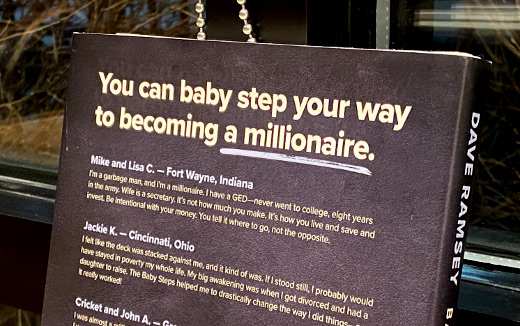My Takeaways from No Hero
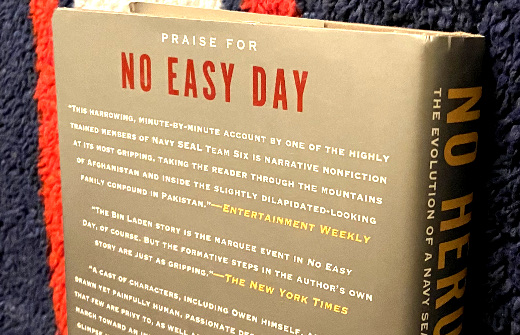
A statement commonly said by Americans when meeting someone who is or has served in the military is, “thank you for your service.” As much as it is said with respect, to me it seems to barely scratch the surface of the commitment, intense training and sacrifice of those who volunteer for a branch of the military. After reading No Hero: The Evolution of a Navy SEAL by Mark Owen, that feeling was only amplified.
Owen is the pen name for a member of U.S. Navy SEAL Team Six that was part of the mission that killed Osama bin Laden. No Hero is a follow-up to his first book, No Easy Day: The Firsthand Account of the Mission that Killed Osama bin Laden, and it tells his life story from his initial interest in being a SEAL to numerous missions around the globe. It was given to me by my “brother-from-another-mother” in response to a phrase he used that I have never heard before. This phrase is among the takeaways I had from this book.
Assess, Prioritize, Act – The book gets into detail of the grueling training designed to weed out those who are not SEAL material. In one such training Owen was in a dark room with a hood over his face and when it was removed he had to react to neutralize the situation all the while surviving. He was taught to assess the entire situation, prioritize it and act accordingly – all within mere seconds. Where most of us are not in life and death situations in our daily lives, this approach to problem solving is one I try to remember when an issue arises. Try is the key word there.
After Action Review – Abbreviated as AAR, it is a report written after a mission with contributions by everyone involved. It is designed to be an honest assessment of what worked and what did not, as well as be shared with other SEALs as a learning tool. In general business, a similar term used is “post-mortem” but they are usually comprised of a meeting where people go around the conference room table and talk of similar wins and losses, but not with the same honesty as an AAR. In the Agile/Scrum world, a retrospective at the end of a sprint is supposed to bring out similar facts and sentiments and is perhaps a little more true than a post-mortem. Where these events try to mirror an AAR, true lessons learned and improvements based on them are needed throughout all worlds.
Three-Foot World – This term was the catalyst for me getting and reading No Hero. One day I was talking with my friend and he said he is trying to control his three-foot world to which I responsed, what world? It comes from a training exercise that Owen participated in where he was free climbing a rock face in the Las Vegas desert. When concerned with falling, his instructor told him to only be concerned with his three-foot world, and make sure he had control of what was in front of him and to forget about how high he was up and falling down. The phrase really resonated with me, and when in the quagmire of my daily work and life I have to focus on my three-foot world and try to control what I truly am able to. Try is the key word there too. Needless to say it is a work in process.
The concept of the Three-Foot World also got me reading more about it beyond this book. Where I found several articles about it, there was no central site on it – no threefootworld.com. Now there is, as I registered the domain name and it is pointing to this very post. I reserve the right to write more on the topic, perhaps once I master it myself.
No Hero is a no holds barred story of the emotions and actions take in war and other conflicts that America has been immersed in recent years. When you read all that goes into what makes a SEAL and what they have to endure in battles, it is thought provoking. I recommend this book to everyone. As I give all my books away, I am sharing this with a friend who is a regular reader of this humble blog whom I believe will truly appreciate this story.
This is from The Hot Iron, a journal on business and technology by Mike Maddaloni.
Did you enjoy this? Subscribe to The Hot Iron by RSS/XML feed or Read by Email
Book Take-Aways • (0) Comments • PermalinkMy Takeaways From Outsmart
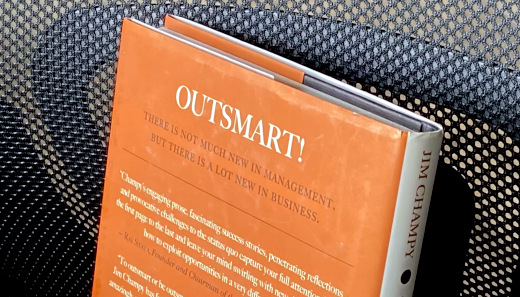
Working hard versus working smart. Some will say you have to do both at the same time, others say it’s an either or proposition. I have often viewed it as a pendulum that was weighted towards working hard, but knowing when to work smart is the challenge that requires literal balance and perspective.
In the book Outsmart!: How to Do What Your Competitors, Jim Champy tells the tales of several businesses and how, around a certain period of time, they were able to rise and outsmart their competitors in various ways. That period of time was the 2000’s, as this book was written in 2008. With that in mind going into reading it, would I have takeaways from it? Yes, and several.
Outsider perspective helps – The majority of the businesses highlighted featured leaders who came into it – the business itself or the industry – as an outsider, namely someone who didn’t grow up in that line of business. Taking a new idea or what was there, they were able to look at it differently than others from within and outside and were able to thrive.
You can change how people think by changing what they do – This quote was related to the story about MinuteClinic, and is one I can personally attest to. Whether a change of venue, responsibility or assignments, doing something different – whether it’s directly aligned with your interests or not – can change your opinion greatly.
Outsourcing not always the answer and more about cost saving than quality – Attributed to one of the owners of S. A. Robotics, it justifies how the firm kept most of its work internal and did not outsource. I agree with this, and I also add the element of time to this, as outsourcing can deliver something much later and with less quality, especially if the focus is on a reduced price.
The business world in 2008 – This book was published before the recession in 2008, and a follow-on to how these business are today, if they are still in business, would be interesting to read. The story of gun manufacturer Smith & Wesson was of high interest to me, as I grew up a few miles from their headquarters in Massachusetts, one that is being relocated to Tennessee due to a changing political climate towards guns in the Bay State. Where Shutterfly was revolutionary back in the mid-2000’s, it would be interesting to see how they compare to others in that space today.
The catalyst for me reading this book was its author himself. Jim Champy was the chairman and CEO of CSC Index, a management consulting firm that was a sister firm to where I was working early in my career. He is most known for, along with Mike Hammer, pioneering the concept of Business Reengineering that swept the corporate world in the 1990’s. When I saw this book, though our paths never crossed I was compelled nonetheless to read about my, um, colleague.Outsmart is a short but good read that shows by example how strategizing and execution of that strategy can make a difference for a business. If you’re looking for inspiration to change and rise above where you are with your business, I recommend this book. As for whom I am giving it to, it’s on its way to my friend John Wall, an avid reader of this humble blog and the co-host of the long-running and best marketing podcast out there, Marketing Over Coffee. Why? Check out his recent episode where he talks about Jibbitz, who is one of the businesses featured in this book.
This is from The Hot Iron, a journal on business and technology by Mike Maddaloni.
Did you enjoy this? Subscribe to The Hot Iron by RSS/XML feed or Read by Email
Book Take-Aways • (0) Comments • PermalinkMy Takeaways From Economics In One Lesson
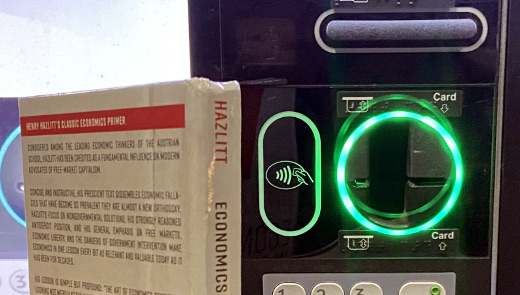
Economics. When you hear that word, what do you think? For some, it's a view of the world and how it operates. For others, they simply ignore it. For myself, as aware as I like to be of what happens in and around me, the topics of economics was always a fragmented one.
Taking Economics 101 in college didn't help things. It may have been a combination of things, including the nickname for my professor being "shaky" which was related to his hand gestures, how much alcohol he reportedly drank and likely both. The constantly exploding red pens in his shirt pockets was another distraction. I will never forget when he typed tests on a manual typewriter, he simply backspaced and put a slash thru mistakes and kept typing. Though these are no excuses, all my memories from that class are non-academic.
When I learned about a book called Economics in One Lesson by Henry Hazlitt, I had to check it out. Both being "one" lesson and being free were enticing to me. The book was offered by the Mises Institute, a libertarian think tank, and I took them up on their offer to receive a printed copy of the book, an offer unfortunately is no longer available. Hazlitt, a libertarian author, originally wrote the book in 1946 and it was revised and extended in 1979. As libertarians (and I am grossly summarizing here) believe in very small government and free markets, I was interested in what I learn from the text, as some of my own world views are in line with this thinking.
As I read through the pages of Economics in One Lesson, it helped me structure the bits and pieces of economics I have collected over the years, and I had several takeaways from it.
Simple examples – To setup what I was about to learn, in the early pages of the book was a hypothetical story of a store keeper who was saving for a new suit but had to spend the money on a new window when one in his shop was broken. As a result there was no net benefit to economy – the window glazer made out but the tailor did not, and neither did the store keeper for that matter. Stories like this and others help set the stage and drive home concepts throughout the book.
Global view – Hazlitt states that to truly study an economic impact you must trace both short and long term impacts and impacts on a special group and everyone impacted by it. He gave examples of laws and decisions made by governments that benefit one group at the expense of another, and that impact may be long after the decision is made and executed upon.
So what is Credit? – A statement that stuck out to me is regarding credit, that is something we already have not something a lender gives us. Granted if I walked into any bank and said that they would laugh at me and want to see my FICO score, but it is something I recall whenever the topic of credit comes up.
Economic Sybil – The idea that we have multiple economic personalities was something I hadn’t thought about. Some of those include being a producer, taxpayer and consumer, and the thinking around each will have some common and uncommon components.
Economics in One Lesson was an enjoyable read, something I wasn’t expecting for a book on this topic. It was written in a way to educate without shaming and didn’t pretend to be the one and only book you should read on economics, as in the end there were suggestions for further study. Where the offer to get this book for free no longer exists, I recommend picking up a copy if you are interested in learning or brushing up on economics. For the giveaway of this book, it is going to stay in the house for now as my lovely wife is interested in brushing up on what she learned here and abroad in economics.
This is from The Hot Iron, a journal on business and technology by Mike Maddaloni.
Did you enjoy this? Subscribe to The Hot Iron by RSS/XML feed or Read by Email
Book Take-Aways • (0) Comments • PermalinkMy Takeaways From Baby Steps Millionaire
Money. The mere mention of the word can evoke all kinds of thoughts and emotions. From joy to concern to comfort to panic to, oh crap, did I pay the electric bill this month?
Most all of us have money in some way, shape or form and the opportunity to do most all we want with it. But could you be a millionaire? I am sure some reading this are, some don’t care, some see no way and maybe some have no idea if they are or not. From game shows to lottery tickets to Austin Powers movies, the milestone of being a millionaire has been one known throughout the world.
But back to the question – could you be a millionaire? Dave Ramsey thinks you can. The long-time radio and TV host of personal finance programming and author has been professing common sense regarding money and finance for decades. Where I have been aware of him and seen and heard his shows on occasion, I have never really dove into what he professes. When I heard of his recent book Baby Steps Millionaire, I was intrigued and picked up a copy.
Baby Steps Millionaire tells the tales of people who became millionaires – they have a net worth of or over one million US dollars and how they achieved it. As I read through the book, a few takeaways formed in my mind.
People and how they did it – Where I am not trying to spoil the book for you if you are equally intrigued to read it, it may not come as a surprise for the majority of them there was no “fast path” and it involved sound spending and investing over time. There are many stories that are somewhat similar in context in how people reigned in spending, cut expenses and made lifestyle choices and saved even when they didn’t think they could. These stories make up the first half of the book, and though after a while they become a little repetitive, Ramsey is merely driving home the point on how you can be a millionaire too.
Survey says – The second half of this book is the results of a survey of millionaires, and builds and heightens the first half with more concrete data. It starts out going into rather detail about how the survey was developed and conducted (maybe all surveys do this, I don’t read many surveys in this kind of detail) and then shows the results of what millionaires say about how they got to where they are. Sure, a few inherited their millions from the infamous long-lost uncle, but many followed the sound money steps that were driven home in the first part of the book to get to where they are.
Off-site storage – Dave Ramsey’s first baby step to financial stability is one I have known for years in setting up an emergency fund with $1,000. If you get into a bind, it’s the thing you break the figurative glass of and tap into, then work to replenish it. Though we have savings accounts of different ilk, my family did not have a specific emergency fund, and now we do. But $1,000? Today?! A small amount comes out of each of my wife and I’s paychecks and goes into the account that is at a bank that isn’t our primary and one we have to make an effort to get to. It’s a good feeling to finally have this.
Baby Steps Millionaire is a good read that I recommend as a friendly reminder of how you can achieve financial goals, whether you want to be a millionaire or not. Where some of it can be repetitive, it is a positive book that shows many examples of how people got onto a financial track and took off. As I give away all books I read, I am giving this one to someone who is getting back on track in many ways, and I hope it gives them inspiration when it comes to the M word.
This is from The Hot Iron, a journal on business and technology by Mike Maddaloni.
Did you enjoy this? Subscribe to The Hot Iron by RSS/XML feed or Read by Email
Book Take-Aways • (0) Comments • PermalinkMy Takeaways From The Best Alternative History Stories Of The 20th Century
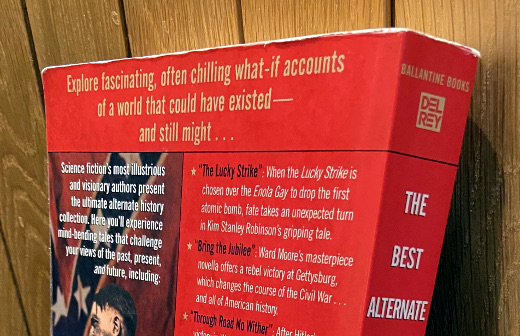
What if? What if the atomic bomb was never dropped on Nagasaki? What if McGovern beat Nixon in the 1972 US Presidential election? What if Hitler was victorious in World War II?
It’s hard to imagine how life as we know it would be if history as we know it was different. Or is it? I recently found this topic little easier to comprehend when a colleague gave me a copy of The Best Alternative History Stories Of The 20th Century.
At over 400 pages, this book has 14 individual stories that fall into the genre called “alternative history.” For those not familiar with this genre, the stories are based on an event or period of time in history that is reimagined with a different outcome. The result is a collection of tales of what could have been different, making you think even more as you turn the pages of this assortment of fiction. Not only was I thinking about alternative outcomes as I read this book, a few takeaways leapt from its pages as well.
I didn’t know this genre existed before this book – Where I have repeated here on the posts of this humble blog that I am no prolific reader, I certainly backed up that statement when it came to alternative history. I had never heard of the genre before I read the book. That helped me get to the several hundred pages as I was intrigued at what would be the “best” of stories.
No two stories were the same – As each tale of an alternative outcome were written by different authors, the stories were as unique as the individuals. Some were short, some were long. Some were painstakingly detailed, others glossed over minutiae in exchange for plot and character development. Some were about a specific event itself and others were related to activities as the result of an alternative history. In the end I mostly appreciated the variety of styles as much as their topics.
I never finished 2 of the stories – Two of the stories were very hard to follow and I decided after several pages to skip them. One was about a period of time I didn’t quite understand when it was and the story was difficult to follow. Another had a very complex style that made it hard for me to read. Where I have read every page of every book I’ve written about, this is the first time I did a fast-forward on a few.
The Best Alternative History Stories Of The 20th Century was unique in how it made me think at different levels, and is a book I highly recommend. When I make more room in my bookshelf I will certainly consider adding alternative history stories to it. As I pass along all books I read, this is going to one of my favorite cousins, both for her enjoyment and to help atone for missing her recent birthday.
This is from The Hot Iron, a journal on business and technology by Mike Maddaloni.
Did you enjoy this? Subscribe to The Hot Iron by RSS/XML feed or Read by Email
Book Take-Aways • (0) Comments • Permalink
